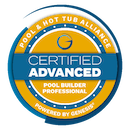The swimming season might be on its last leg, but when has that ever stopped you from diving into your in-ground pool? Well, before you jump in, do you even know if your pool is safe to swim in? And no… we are not asking that question because fall is just around the corner; we are asking that because of the germs.
Germs can be found pretty much anywhere, and your pool is no exception. This means that proper pool service and repairs are critical to keeping illnesses at bay while swimming.
How Can Your Pool Water Make You Sick?
Recreational water illnesses (RWIs) are diseases that can be contracted from your pool water if it is contaminated with germs and bacteria like Cryptosporidium or “crypto,” Giardia, Shigella, norovirus, and Escherichia coli or “E. coli.” Swallowing even a small amount of water contaminated with germs can make you sick. Other forms of contact with germ-infested water, such as breathing its mist, can also make you sick.
The most common cause of RWIs is water contamination, which occurs when someone who is sick and carrying germs enters a pool. However, the contamination can also be a result of growing bacteria in the pool water.
Diarrhea, bacterial skin infections, ear infection, chest congestion, and eye pain are the most common types of RWIs.
While RWIs may sound frightening, your chances of contracting an illness from your pool water are significantly reduced if your pool is properly serviced and maintained.
Maintain Proper Chlorine and pH Levels to Avoid RWIs
Pool maintenance entails more than simply skimming leaves and scrubbing algae away. You must also stay on top of your pool’s chlorine level and pH.
When mixed with water, chlorine produces a “weak” acid that can effectively kill disease-causing bacteria, viruses, fungi, and protozoa. It is for this reason that chlorine is used as a disinfectant in swimming pools. The CDC recommends a free chlorine level of 1 part per million (ppm) for your pool.
However, the pH of your pool is also important.
Chlorine can only disinfect as long as the pH of your pool is within a certain range. The CDC recommends a pH range of 7.2 to 7.8. Chlorine is notably less effective at killing germs when the pH is too high. On the other hand, if the pH is too low, it can lead to pipe corrosion.
To ensure a perfect mix of germ-killing and pool-system longevity, you must stay on top of your pool’s chlorine levels and pH ranges. Furthermore, keeping the pH at the ideal range reduces skin and eye discomfort, which can occur at both very high (>7.8) and very low (<7.2) pH levels.
Additional Swimming Safety Tips
- If you (or your child) are sick or are recovering, do not enter a pool to avoid transmitting germs.
- Take a quick shower before entering the pool to reduce the amount of dirt and sweat you bring into the water.
- To avoid ear infections, dry your ears after getting out of the water. Consider wearing a swim cap or earplugs if you have a history of ear infections.
- Remind your kids to not swallow pool water.
If you are looking for professional pool service and maintenance in Holland, Ohio, or the surrounding areas contact Hawaiian Pools today. Call us at (419) 878.7946 or write to us at mkerr@hawaiianpoolbuilders.com to learn more about how our APSP certified service technicians can help you make the most of this summer season.







